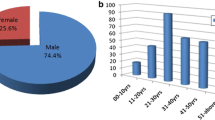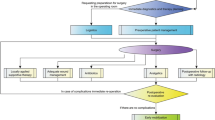Abstract
Purpose
This study examined a single center’s experience with regards to etiology and distribution of fractures treated from July 2015 to August 2016 in Shanghai, China.
Methods
The medical records of 621 patients with craniomaxillofacial fractures were reviewed. Patient notes and radiographic images were analyzed for detailed injury data. Age, gender, etiology, and site of fracture were examined. Chi-square test was used to analyze the causes of single and multiple fractures. p < 0.05 was considered statistically significant.
Results
This study included 426 male and 195 female with a male-to-female ratio of 2.18:1, among which 28.3% were between 19 and 29 years (n = 176). In all the fracture sites, orbit was most commonly involved (n = 319, 51.4%). Traffic accidents (n = 304, 49%) were the most common cause of injury in this study, while ground-level falls were the most common cause of injury in children (n = 19, 41.3%). The probability of multiple fractures due to falling from height (88.6%, p < 0.05) and traffic accidents (73.3%, p < 0.05) were significantly higher than that of other injuries. Orbital fractures have the highest surgical rate (n = 288, 90.3%).
Conclusion
Craniomaxillofacial fractures predominantly occur in young men, due to traffic accidents. Orbit was involved in most cases. Falling from height and traffic accidents is more likely to cause multiple fractures.




Similar content being viewed by others
References
Regmi KP, Tu J, Ge S, et al. Retrospective clinical study of maxillary sagittal fractures: predictors of postoperative outcome. J Oral Maxillofac Surg. 2017;75:576.
Li YS, Tian WD, Li SW, Liu L. Retrospective analysis of 3,958 patients with facial injuries. Zhonghua Kou Qiang Yi Xue Za Zhi. 2006;41:385.
Franklin CC, Weiss JM. Stopping sports injuries in kids: an overview of the last year in publications. Curr Opin Pediatr. 2012;24:64.
Eggensperger Wymann NM, Hölzle A, Zachariou Z, Iizuka T. Pediatric craniofacial trauma. J Oral Maxillofac Surg. 2008;66:58.
Posnick JC, Wells M, Pron GE. Pediatric facial fractures: evolving patterns of treatment. J Oral Maxillofac Surg. 1993;51:844.
Wheeler J, Phillips J. Pediatric facial fractures and potential long-term growth disturbances. Craniomaxillofac Trauma Reconstr. 2011;4:43.
Demianczuk AN, Verchere C, Phillips JH. The effect on facial growth of pediatric mandibular fractures. J Craniofac Surg. 1999;10:323.
Ferreira PC, Amarante JM, Silva PN, et al. Retrospective study of 1251 maxillofacial fractures in children and adolescents. Plast Reconstr Surg. 2005;115:1500.
Thorén H, Iso-Kungas P, Iizuka T, Lindqvist C, Törnwall J. Changing trends in causes and patterns of facial fractures in children. Oral Surg Oral Med Oral Pathol Oral Radiol Endod. 2009;107:318.
Lin S, Levin L, Goldman S, Sela G. Dento-alveolar and maxillofacial injuries: a 5-year multi-center study. Part 2: severity and location. Dent Traumatol. 2008;24:56.
Smith H, Peek-Asa C, Nesheim D, Nish A, Normandin P, Sahr S. Etiology, diagnosis, and characteristics of facial fracture at a midwestern level I trauma center. J Trauma Nurs. 2012;19:57.
Chen C, Yang Y, Gong X, He Y, An J, Zhang Y. A retrospective study of 1 009 patients with oral and maxillofacial fresh trauma. Zhonghua Kou Qiang Yi Xue Za Zhi. 2015;50:650.
Zhou HH, Liu Q, Yang RT, Li Z, Li ZB. Maxillofacial fractures in women and men: a 10-year retrospective study. J Oral Maxillofac Surg. 2015;73:2181.
Chrcanovic BR. Factors influencing the incidence of maxillofacial fractures. Oral Maxillofac Surg. 2012;16:3.
Zhou HH, Liu Q, Yang RT, Li Z, Li ZB. Traumatic head injuries in patients with maxillofacial fractures: a retrospective case-control study. Dent Traumatol. 2015;31:209.
Mijiti A, Ling W, Tuerdi M, et al. Epidemiological analysis of maxillofacial fractures treated at a university hospital, Xinjiang, China: a 5-year retrospective study. J Craniomaxillofac Surg. 2014;42:227.
Yang RT, Li Z, Li ZB. Maxillofacial injuries in infants and preschools: a 2.5-year study. J Craniofac Surg. 2014;25:964.
Fasola AO, Nyako EA, Obiechina AE, Arotiba JT. Trends in the characteristics of maxillofacial fractures in Nigeria. J Oral Maxillofac Surg. 2003;61:1140.
Bo B, Gu X, Zhou S. An epidemiologic survey of facial fracture from vehicles. Chin J Oral Maxillofac Surg. 1998;1:12–14.
Li SJ, Liu YP. Survey of epidemiological characters of maxillofacial injuries in hospitalized patients. Chin J Clin Rehabilit. 2003;7:4376.
Chen H, Liu YP, Liu B. A clinical analysis of 1001 oral and maxillofacial traumatic cases. China J Oral Maxillofac Surg. 2012, 2:129–133.
Shi J, Qiu WL, Xu B, Tang YS. A retrospective study of 1420 oral and maxillofacial traumatic cases. Shanghai Kou Qiang Yi Xue. 2008;17:574.
Cagatay HH, Ekinci M, Pamukcu C, Oba ME, Akcal Ozcan A, Karsidag S. Retrospective analysis of 132 patients with orbital fracture. Ulus Travma Acil Cerrahi Derg. 2013;19:449.
DeFazio MV, Fan KL, Avashia YJ, Danton GH, Thaller SR. Fractures of the pediatric zygoma: a review of the clinical trends, management strategies, and outcomes associated with zygomatic fractures in children. J Craniofac Surg. 2013;24:1891.
Lee SW, Jeong YW, Myung Y. Revision surgery for zygoma reduction: causes, indications, solutions, and results from a 5-year review of 341 cases. Aesthet Plast Surg. 2017;41:161.
Riaz N, Chatha AA, Warraich RA, Hanif S, Chinar KA, Khan SR. Ophthalmic injuries in orbito-zygomatic fractures. J Coll Physicians Surg Pak. 2014;24:649.
Boyette JR, Pemberton JD, Bonillavelez J. Management of orbital fractures: challenges and solutions. Clin Ophthalmol. 2015;9:2127.
Kim BB, Qaqish C, Frangos J, et al. Oculocardiac reflex induced by an orbital floor fracture: report of a case and review of the literature. J Oral Maxillofac Surg. 2012;70(11):2614.
Burnstine MA. Clinical recommendations for repair of isolated orbital floor fractures: an evidence-based analysis. Ophthalmology. 2002;109(7):1207–10.
Burnstine MA. Clinical recommendations for repair of orbital facial fractures. Curr Opin Ophthalmol. 2003;14(5):236–40.
Gart MS, Gosain AK. Evidence-based medicine: orbital floor fractures. Plast Reconstr Surg. 2014;134(6):1345.
Yano H, Nakano M, Anraku K, et al. A consecutive case review of orbital blowout fractures and recommendations for comprehensive management. Plast Reconstr Surg. 2009;124(2):602–11.
Funding
This study received no funding.
Author information
Authors and Affiliations
Contributions
All authors contributed to study conception and design, data analysis, and drafting the manuscript. All authors read and approved the final manuscript.
Corresponding author
Ethics declarations
Conflict of interest
Yang Lu and Hangqi Shen are the co-first authors. Yang Lu, Hangqi Shen, Jiayi Wang, and Xiaofeng Lu declare that they have no conflict of interest.
Statement of human rights
The study was approved by the School of medicine ethics Committee, Shanghai Jiao Tong University. It was performed in accordance with the ethical standards as laid down in the 1964 Declaration of Helsinki and its later amendments or comparable ethical standards.
Informed consent
For this type of study, formal consent is not required.
Rights and permissions
About this article
Cite this article
Lu, Y., Shen, H., Wang, J. et al. Characteristics on 621 cases of craniomaxillofacial fractures. Eur J Trauma Emerg Surg 45, 893–900 (2019). https://doi.org/10.1007/s00068-018-0950-7
Received:
Accepted:
Published:
Issue Date:
DOI: https://doi.org/10.1007/s00068-018-0950-7




